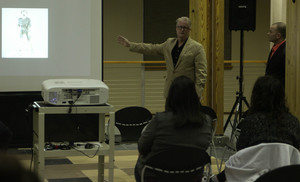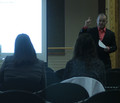Smith, Tucker close 2018 Graves Lectures Series

CHADRON – Dr. T. Smith, associate professor of Communication and Social Sciences, and Dr. Deane Tucker, professor of English and Humanities, presented the final Graves Lecture of the semester Tuesday, April 17, in the Mari Sandoz High Plains Heritage Center Chicoine Atrium.
Smith and Tucker teach Cuba Libre, an upper-division capstone course in the Essential Studies Program. Both have taken two 10-day-long trips to Cuba for the class and are preparing to take another group of students in the Fall.
From their visits, the pair are aware of one particular thing: Cubans are still living the 1959 Cuban Revolution. It is the only thing typically found on buildings and billboards throughout the country.
According to Smith, Cuba is a socialist country that provides many basic needs for its citizens.
“Cuba does a lot of things well, in the respect that public goods are provided,” Smith said. “In some ways, health care is better than the United States, and it is free and universal. Literacy rates are the same or better than those in the United States.”
Smith and Tucker have become aware of another factor – there is no commercial advertising.
“Public space is filled with the face of the revolution. There is no real external consumption push in Cuba,” Smith said.
Not having consumption is what allows the revolution to constantly be there even through change, according to Tucker.
Smith said he and Tucker believe that the lack of commercial advertising in Cuba could affect how Cubans think.
“Our hypothesis is that collective memory, or external memory, is different than the way you remember inside of your head. In Cuba, there is such a proliferation of collective, external memory of the revolution that we are arguing Cuban embrace of that memory is exceptional and an exceptional kind of buying into that collective memory might take place,” Smith said. “If we are going to share a memory we create from internal, but if there is so much external memory in Cuba, then it may be affecting the way people look at the revolution.”
Tucker said when thinking about the United States’ collective memory, a lot comes from advertising.
“The huge void of advertising and promotion in Cuba is replaced with external memory of the revolution,” Tucker said.
Smith and Tucker hypothesize that internal memory is not solely driving Cubans’ memory.
“The free and open discourse stemming from individualism to be the main driver of internal memory is being heavily influenced from the external state,” Smith said.
Smith and Tucker hope that students and community members join their class and go to Cuba to test this and other hypotheses directly.
The Graves Lecture Series will return in the Fall.
Category: Campus News, Graves Lecture Series, Sandoz Society

